Upregulation of P-glycoprotein by probiotics in intestinal epithelial cells and in the dextran sulfate sodium model of colitis in mice
- PMID: 21350189
- PMCID: PMC3119110
- DOI: 10.1152/ajpgi.00027.2011
Upregulation of P-glycoprotein by probiotics in intestinal epithelial cells and in the dextran sulfate sodium model of colitis in mice
Abstract
P-glycoprotein (P-gp) mediates efflux of xenobiotics and bacterial toxins from the intestinal mucosa into the lumen. Dysregulation of P-gp has been implicated in inflammatory bowel disease. Certain probiotics have been shown to be effective in treating inflammatory bowel disease. However, direct effects of probiotics on P-gp are not known. Current studies examined the effects of Lactobacilli on P-gp function and expression in intestinal epithelial cells. Caco-2 monolayers and a mouse model of dextran sulfate sodium-induced colitis were utilized. P-gp activity was measured as verapamil-sensitive [(3)H]digoxin transepithelial flux. Multidrug resistant 1 (MDR1)/P-gp expression was measured by real-time quantitative PCR and immunoblotting. Culture supernatant (CS; 1:10 or 1:50, 24 h) of Lactobacillus acidophilus or Lactobacillus rhamnosus treatment of differentiated Caco-2 monolayers (21 days postplating) increased (∼3-fold) MDR1/P-gp mRNA and protein levels. L. acidophilus or L. rhamnosus CS stimulated P-gp activity (∼2-fold, P < 0.05) via phosphoinositide 3-kinase and ERK1/2 MAPK pathways. In mice, L. acidophilus or L. rhamnosus treatment (3 × 10(9) colony-forming units) increased mdr1a/P-gp mRNA and protein expression in the ileum and colon (2- to 3-fold). In the dextran sulfate sodium (DSS)-induced colitis model (3% DSS in drinking water for 7 days), the degree of colitis as judged by histological damage and myeloperoxidase activity was reduced by L. acidophilus. L. acidophilus treatment to DSS-treated mice blocked the reduced expression of mdr1a/P-gp mRNA and protein in the distal colon. These findings suggest that Lactobacilli or their soluble factors stimulate P-gp expression and function under normal and inflammatory conditions. These data provide insights into a novel mechanism involving P-gp upregulation in beneficial effects of probiotics in intestinal inflammatory disorders.
Figures
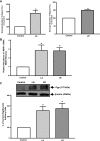
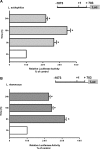
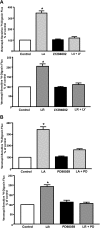
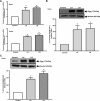
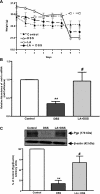
Similar articles
-
Lactobacillus acidophilus attenuates downregulation of DRA function and expression in inflammatory models.Am J Physiol Gastrointest Liver Physiol. 2014 Sep 15;307(6):G623-31. doi: 10.1152/ajpgi.00104.2014. Epub 2014 Jul 24. Am J Physiol Gastrointest Liver Physiol. 2014. PMID: 25059823 Free PMC article.
-
Probiotic administration alters the gut flora and attenuates colitis in mice administered dextran sodium sulfate.J Gastroenterol Hepatol. 2008 Dec;23(12):1834-9. doi: 10.1111/j.1440-1746.2008.05723.x. J Gastroenterol Hepatol. 2008. PMID: 19120873
-
Efficacy profiles for different concentrations of Lactobacillus acidophilus in experimental colitis.World J Gastroenterol. 2013 Aug 28;19(32):5347-56. doi: 10.3748/wjg.v19.i32.5347. World J Gastroenterol. 2013. PMID: 23983440 Free PMC article.
-
Probiotics and prevention of Clostridium difficile infection.Anaerobe. 2017 Jun;45:114-119. doi: 10.1016/j.anaerobe.2016.12.007. Epub 2016 Dec 14. Anaerobe. 2017. PMID: 27988389 Review.
-
Evaluation of the Effect of Probiotic Supplementation on Intestinal Barrier Integrity and Epithelial Damage in Colitis Disease: A Systematic Review.Nutr Rev. 2025 Jul 1;83(7):e1782-e1797. doi: 10.1093/nutrit/nuae180. Nutr Rev. 2025. PMID: 39602817 Free PMC article.
Cited by
-
Keratinocyte growth factor-2 stimulates P-glycoprotein expression and function in intestinal epithelial cells.Am J Physiol Gastrointest Liver Physiol. 2013 Mar 15;304(6):G615-22. doi: 10.1152/ajpgi.00445.2012. Epub 2013 Jan 17. Am J Physiol Gastrointest Liver Physiol. 2013. PMID: 23328208 Free PMC article.
-
Glyceollin transport, metabolism, and effects on p-glycoprotein function in Caco-2 cells.J Med Food. 2014 Apr;17(4):462-71. doi: 10.1089/jmf.2013.0115. Epub 2014 Jan 29. J Med Food. 2014. PMID: 24476214 Free PMC article.
-
Lactobacillus acidophilus attenuates downregulation of DRA function and expression in inflammatory models.Am J Physiol Gastrointest Liver Physiol. 2014 Sep 15;307(6):G623-31. doi: 10.1152/ajpgi.00104.2014. Epub 2014 Jul 24. Am J Physiol Gastrointest Liver Physiol. 2014. PMID: 25059823 Free PMC article.
-
Lactobacillus rhamnosus GG culture supernatant ameliorates acute alcohol-induced intestinal permeability and liver injury.Am J Physiol Gastrointest Liver Physiol. 2012 Jul;303(1):G32-41. doi: 10.1152/ajpgi.00024.2012. Epub 2012 Apr 26. Am J Physiol Gastrointest Liver Physiol. 2012. PMID: 22538402 Free PMC article.
-
Biphasic regulation of P-glycoprotein function and expression by NO donors in Caco-2 cells.Acta Pharmacol Sin. 2012 Jun;33(6):767-74. doi: 10.1038/aps.2012.25. Epub 2012 Apr 30. Acta Pharmacol Sin. 2012. PMID: 22543702 Free PMC article.
References
-
- Blokzijl H, Vander Borght S, Bok LI, Libbrecht L, Geuken M, van den Heuvel FA, Dijkstra G, Roskams TA, Moshage H, Jansen PL, Faber KN. Decreased P-glycoprotein (P-gp/MDR1) expression in inflamed human intestinal epithelium is independent of PXR protein levels. Inflamm Bowel Dis 13: 710–720, 2007 - PubMed
-
- Bradford M. A rapid and sensitive method for the quantitation of microgram quantities of protein utilizing the principle of protein-dye binding. Anal Biochem 72: 248–254, 1976 - PubMed
-
- Broekaert IJ, Nanthakumar NN, Walker WA. Secreted probiotic factors ameliorate enteropathogenic infection in zinc-deficient human Caco2 and T84 cell lines. Pediatr Res 62: 139–144, 2007 - PubMed
Publication types
MeSH terms
Substances
Grants and funding
LinkOut - more resources
Full Text Sources
Research Materials
Miscellaneous

